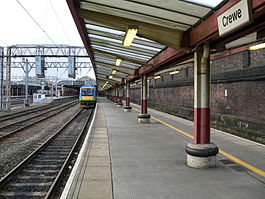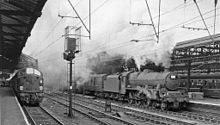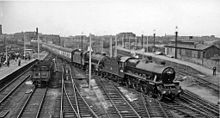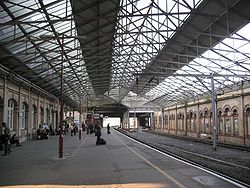- Crewe railway station
-
Crewe 

A Central Trains Class 170 at Platform 2 at the southern end of the station Location Place Crewe Local authority Cheshire East Coordinates 53°05′20″N 2°25′59″W / 53.089°N 2.433°WCoordinates: 53°05′20″N 2°25′59″W / 53.089°N 2.433°W Operations Station code CRE Managed by Virgin Trains Number of platforms 12 Live arrivals/departures and station information
from National Rail EnquiriesAnnual rail passenger usage 2004/05 * 1.528 million 2005/06 *  1.652 million
1.652 million2006/07 *  1.750 million
1.750 million2007/08 *  1.900 million
1.900 million2008/09 *  1.954 million
1.954 million2009/10 *  2.035 million
2.035 millionHistory 4 July 1837 Opened 1861 rebuilt National Rail - UK railway stations A B C D E F G H I J K L M N O P Q R S T U V W X Y Z * Annual passenger usage based on sales of tickets in stated financial year(s) which end or originate at Crewe from Office of Rail Regulation statistics. Please note: methodology may vary year on year. Crewe railway station was completed in 1837 and is one of the most historic railway stations in the world. Built in fields near to Crewe Hall, it originally served the village of Crewe with a population (c. 1831) of just 70 residents.[1] Crewe was chosen after Winsford, seven miles to the north, had rejected an earlier proposal, as had local landowners in neighbouring Nantwich, four miles away.
Nowadays, as well as serving the town of Crewe that has grown near it, it still operates as a major junction on the West Coast Main Line (WCML). It also serves as a major station on the WCML and as a major rail gateway for the North West. On the WCML, Crewe is located 158 miles north of London Euston, and 243 miles south of Glasgow Central.
In April 2006, Network Rail organised its maintenance and train control operations into 26 "Routes". The main line through Crewe forms part of Route 18 (The West Coast Main Line). The line from Shrewsbury and South Wales to the junction south of Crewe station is Route 14 (South and Central Wales and Borders). The North Wales Coast Line to Chester and North Wales is Route 22 (North Wales and Borders) and the Crewe to Manchester Line forms a part of Route 20 (North West Urban). The Crewe to Derby Line is electrified between Crewe, Kidsgrove and Stoke-on-Trent to enable it to serve as a diversionary route and therefore forms a part of Route 18.
Crewe currently has 12 platforms in regular use. There is a modern passenger entrance containing a bookshop and ticket office. Passengers access the platforms via a footbridge, stairs and lifts. The platforms have buildings dating from the 19th century containing two more bookshops, bars, buffets and waiting rooms. The last major expenditure on the station was in 1985, when the entire track layout was remodelled and the station facilities updated during a three-month period when few trains called at the station.
Contents
History
Early years
When it was built, Crewe railway station was truly unique,[clarification needed] and has set many 'firsts'. It was the first station in the world to have its own railway hotel (The Crewe Arms, 1838, still in use). It was the first to be completely rebuilt owing to the need for expansion. It was the first to form a junction between more than two companies. It was the first to have a completely independent railway system built around it, to ease traffic congestion.
The story begins on 4 July 1837, with the opening of the Grand Junction Railway. The purpose of this railway was to link the four largest cities of England by joining the existing Liverpool and Manchester Railway with the projected London and Birmingham railway. The line, which was the first long-distance railway in the world, ran from Curzon Street railway station in Birmingham to Dallam in Warrington, Cheshire, where it made an end-on junction with the Warrington and Newton Railway, a branch of the L&M.
Conceived as a through route, the GJR was not interested in serving towns en-route. Wolverhampton, for instance, was by-passed by half a mile because it did not lie on the intended route, and no central station was built for several years, instead a small Wolverhampton station, later renamed Wednesfield Heath was deemed to suffice. The line passed through Stafford, also opened on 4 July 1837. A station was built in the township of Crewe, which formed part of the ancient parish of Barthomley. The township later became a civil parish in its own right, and, later still, was renamed Crewe Green to avoid confusion with the town of Crewe, which was adjacent to it. The actual position of the station was at the point where the line crossed the turnpike road linking the Trent and Mersey and the Shropshire Union Canals. Since the land was bought from the Earl of Crewe, whose mansion stood nearby, and it was located in the township of Crewe, the station was called Crewe. The railway station gave its name to the town of Crewe that was actually situated in the ancient parish of Coppenhall. In 1936, the railway station was transferred from the civil parish of Crewe to the then municipal borough of Crewe.[2]
As soon as the station opened it was seen to be at a useful point to begin a branch line to the county town of Chester. The Chester and Crewe Railway was formed and was absorbed by the GJR shortly before it opened to traffic in 1840. A locomotive depot was built at the station, to serve the Chester line, and to provide banking engines to assist trains southwards from Crewe up the Madeley Incline, a modest gradient which was a challenge to the small engines of the day.
By 1841, the Chester line was seen as a starting point for a new trunk line to Holyhead, to provide the fastest route to Ireland, and the importance of Crewe as a junction station began to be established. This was given further endorsement when the Manchester and Birmingham Railway, a separate undertaking which had hoped to build a wholly independent line linking the two cities, shorter than the GJR, decided that it would be uneconomical to compete with that line over the greater part of its length, and decided to divert its own line to meet the GJR at Crewe. Teething squabbles between the companies delayed the running of through services for a while, and the M&B had to build a temporary station of their own, part of which survives today as an isolated platform next to the North Junction, at the start of the line to Manchester.
In 1842 the GJR decided to move its locomotive works from Edge Hill in Liverpool to Crewe, siting the works to the north of the junction between the Warrington and Chester lines. To house the workforce and company management the town of Crewe was built by the company to the north of the works.
London & North Western Railway
In 1845 the GJR merged with the London and Birmingham and the Liverpool and Manchester railways to form the London and North Western Railway Company, which until its demise in 1923 was the largest company in the world. The new company extended the existing lines to Holyhead, the Warrington line to Lancaster and Carlisle, the Manchester line to Leeds, and built the new Crewe and Shrewsbury Railway to Shrewsbury to join the joint GWR owned Shrewsbury and Hereford Railway, which provided connections to South Wales. The North Staffordshire Railway built a line from Stoke-on-Trent, joining the LNWR from the South East. Crewe was therefore the centre of a wide-ranging railway network, and freight-handling facilities grew up to the south of the station.
To cope with the increase of traffic, the station was rebuilt in 1861, the buildings facing each other on the present platforms 5 and 6 dating from this time. At the same time the works was extensively redeveloped and enlarged, and the town also considerably enlarged, under the leadership of John Ramsbottom, a Stockport man who had become Locomotive Superintendent for the whole company. Locomotive construction, hitherto divided with Wolverton (on the London and Birmingham Railway) was concentrated at Crewe. Ramsbottom also built a steelworks, the first in the world to make large-scale use of the Bessemer process, as only the LNWR required enough steel to keep a Bessemer plant continuously occupied. He also introduced mass-production techniques, whereby as many parts as possible were identical between one engine and another.
Ramsbottom retired in 1871 and was succeeded by the legendary Frank Webb, a colourful and controversial figure who was known as 'The Uncrowned King of Crewe'.
By the 1890s Crewe junctions had become so busy that a survey revealed 1,000 trains passing within a 24-hour period. Since half of these were freight trains which did not need to call at the station, the company decided to build a completely separate four-track railway line passing to the west of the station, joining the existing lines beyond the north and south junctions, burrowing beneath them and avoiding them completely. This huge undertaking also included a vast marshalling yard to the south of the station at Basford Hall, a revolutionary 'tranship shed' which allowed fast transfer of freight from wagons to road vehicles under cover, and the increase in the size of the passenger station by one-half again.
London Midland and Scottish Railway
In 1923 the LNWR became part of the London, Midland and Scottish railway group. Crewe remained the major centre for locomotive construction. In 1938-39 the signal boxes at North and South Junctions were completely reconstructed as massive concrete structures to withstand air raids, and remained in use until the resignalling project in 1985. The North Junction signal box can now be visited as part of the Crewe Heritage Centre. Although the railway station is virtually synonymous with the town of Crewe, it was not actually incorporated within the borders of the borough of Crewe until the late 1930s, as it lies about 1 mile to the south east of the actual town centre.
With the exception of two new signal boxes and associated greatly improved colour light signalling, track circuiting and electrically operated track points, train operation at Crewe changed little in over fifty years. The trains did become longer and heavier and were hauled by larger engines, which required increased supplies of water to be taken on board before departure, but the number of passenger trains using Crewe Station and the method of operation did not vary greatly despite the passage of two world wars. Trains continued to divide at Crewe with the front portion for Manchester and the rear for Liverpool. The station pilot engine always had a pair of restaurant cars in a bay platform ready to attach to a morning service to London. Always there were extra coaches waiting to be attached to overcrowded trains. In addition to passengers there were vast quantities of mail, parcels and even live animals and birds of all descriptions transported in specially designed transit crates. When necessary the station staff had to feed and water these special passengers, which travelled in copious luggage vans.
British Railways
In 1948 the LMS was nationalised as British Railways, London Midland Region. Nationalisation greatly facilitated the modernisation of British Railways and, after a false start developing new improved steam engines, electrification came, along with diesel power and fixed-formation air-braked trains. These changes had a significant effect on Crewe station. Notably, the variation in station use caused firstly by the electrification in stages of the West Coast Main Line between 1959 and 1974 and secondly by the general end of steam traction on Britain's railways. Following the completion of Electrification in 1974, trains did not need to change locomotives at Crewe, except for the London to Chester and Holyhead service. Many locomotive hauled trains were replaced by electric or diesel multiple unit trains, with much faster turn-round times. Additionally, two local branch lines had closed, which resulted in fewer trains terminating at Crewe. However, compensating for the decline of local passenger traffic, the reduction in mail and parcels traffic and the total elimination of livestock carriage, came the great increase in inter-city passenger traffic and the need for even faster, smoother and more efficient handling of passenger trains.
Present day
In 1985 the entire track layout was modernised, simplified and reduced, eliminating a vast array of points and crossings and allowing 80 mph running over the North Junction. At the same time all but one of the six 1902 extension platforms were taken out of use.
Crewe Works, the diesel locomotive depot & the electric locomotive depot are all situated nearby.
Schematic layout
Rail network in the Crewe area LegendCrewe Works 









West Coast Main Line North Wales Coast Line 









Crewe Electric Depot 



















Coal Yard Junction 



















Crewe to Manchester Line Salop Goods Junction 









Crewe North Junction 









Crewe Crewe Diesel Depot 









Welsh Marches Line 









Crewe South Junction Wagon Shop 









Crewe-Derby Line South Yard 









Crewe Carriage Sheds 









Basford Wood Basford Hall Yard 





























Basford Hall Junction 









West Coast Main Line Current services
During the day, there are 22 trains passing through every hour (with additional less frequent services). As a summary:
- Virgin Trains operates 2tph to London Euston
- London Midland operates 1tph services to London Euston via Stoke-on-Trent.
- Virgin Trains operates 1tph to Birmingham New Street
- London Midland operates 2tph to Birmingham New Street.
- Virgin Trains operates 1tph to Glasgow Central or Edinburgh Waverley.
- Virgin Trains operates 1tph to Manchester Piccadilly calling Wilmslow and Stockport
- Arriva Trains Wales operates 1tph to Manchester Piccadilly calling Wilmslow and Stockport
- Northern Rail operates 1tph to Manchester Piccadilly via Manchester Airport
- Northern Rail operates 1tph to Manchester Piccadilly via Stockport
- Virgin Trains operates hourly services to Chester with some services continuing to Bangor, Holyhead and one per day to Wrexham.
- Arriva Trains Wales operates hourly express services to Carmarthen via Cardiff Central extending every other hour to Milford Haven.
- Arriva Trains Wales operates an hourly shuttle service to Chester
- Arriva Trains Wales operates 1 train a day to Birmingham New Street station via Stafford and one per day to Birmingham via Shrewsbury.
- Arriva Trains Wales operate a daily limited-stop express south to Cardiff Central and north to Holyhead.
- East Midlands Trains operates hourly service to Derby via Stoke-on-Trent.
- London Midland operates 2tph to Liverpool Lime Street.
- CrossCountry provide limited daily services to Manchester and the South West (reduced as of 2009).
Preceding station  National Rail
National RailFollowing station Nantwich Arriva Trains Wales
Welsh Marches LineWilmslow Shrewsbury Arriva Trains Wales
North-South "Premier" serviceChester Terminus or Stafford Arriva Trains Wales
North Wales Coast LineChester Terminus East Midlands Trains
Crewe to Derby LineAlsager London Euston First ScotRail
Caledonian SleeperPreston Stafford London Midland
Birmingham - LiverpoolWinsford Terminus London Midland
London - CreweAlsager Terminus Northern Rail
Crewe to Manchester LineSandbach Stafford CrossCountry
Cross Country NetworkWilmslow Wolverhampton Virgin Trains
Birmingham - Glasgow/EdinburghWarrington
Bank QuayStafford Virgin Trains
London - LiverpoolRuncorn Stafford
or London EustonVirgin Trains
London - ManchesterWilmslow Milton Keynes
CentralVirgin Trains
North Wales Coast LineChester Platform Use
- Platform 1 - Northern Rail stopping services to and from Manchester Piccadilly and Southbound London Midland services to Birmingham New Street.
- Platform 2 - Extra Capacity.
- Platform 3 - London Midland services to and from London Euston.
- Platform 4 - East Midlands Trains services to and from Derby.
- Platform 5 - Virgin Trains Northbound services to Manchester Piccadilly and Southbound to Birmingham New Street and London Euston.
- Platform 6 - Arriva Trains Wales services Northbound to Manchester Picadilly and Southbound to Cardiff and beyond. Some Virgin Trains services also use this platform along with Cross Country.
- Platform 7 - Arriva Trains Wales stopping services to and from Shrewsbury.
- Platform 8 - Extra Capacity.
- Platform 9 - Arriva Trains Wales hourly shuttle service to Chester.
- Platform 10 - Extra Capacity.
- Platform 11 - Virgin Trains Northbound services to Glasgow, Edinburgh, Chester and North Wales and London Midland Northbound services to Liverpool Lime Street.
- Platform 12 - Extra Capacity.
In the SRA's 2002/03 financial year 773,969 people joined the railway system at Crewe railway station, and 763,846 left it there (tickets sold at Crewe, and tickets sold to Crewe; figure does not include passengers interchanging between one rail service and another).[3]
Future
In 2007 Network Rail published a proposal to replace the existing Crewe station with a new station located approximately 1 mile to the south in the area of the current Basford Hall freight yard, adjacent to the A500 road and with new links to the M6 motorway; this proposal is claimed to be better suited to the operations of the modern railway as it is estimated that the existing station will be at 125% of its operating capacity in the mid-2020s, and the new station will have a more efficient track layout with fewer conflicting train movements. It is, however, unclear how the line from the south-east (Stoke-on-Trent) and south-west (Shrewsbury) would access the new site. It has also been proposed in a related development that a "Crewe Town" station would be built nearer the town centre on the Chester line, with a shuttle service to the new main station.[1][2] In 2009 the station was identified as one of the ten worst category B interchange stations for mystery shopper assessment of fabric and environment, and is set to receive a share of £50m funding for improvements.[4]
The proposal to move the station has now been abandoned and instead maintenance work is being carried out on the current building.[5] Cheshire East Council is completing a new regeneration master plan for Crewe, which includes the railway station.[6]
Notes and references
Notes
- ^ Guardian newspaper article, The beauty of Crewe (6 December 2005). Retrieval Date: 10 August 2007.
- ^ Chambers (2007, pp. 76, 94); Dunn (1987, p. 26); Ollerhead (2008, pp. 7, 10, 16). "Crewe (near Wybunbury)". GENUKI (UK & Ireland Genealogy). http://www.ukbmd.org.uk/genuki/chs/crewe1.html. Retrieved 3 February 2009.. The unusual relationship between the town of Crewe and the civil parish of Crewe, mediated by the railway station, is described in the following riddle: "The place which is Crewe is not Crewe, and the place which is not Crewe is Crewe."Curran et al. (1984, p. 2).
- ^ The usage information (Station Entries and Station Exits) is based on ticket sales in the financial year 2002/03 and covers all National Rail stations. It does not include those stations that are owned by TfL. The calculation of station usage levels uses sales recorded in the railway ticketing system prior to their allocation to individual operators. It does not take into account any changes of train during the course of a journey. The ticketing system does not record certain journeys made using TfL bought travelcards, TfL Freedom Passes, staff travel passes and certain other PTE specific products. Continued usage notes, and Excel format table for all stations available.
- ^ "£50m revamp for 'worst stations'". BBC News. 2009-11-17. http://news.bbc.co.uk/1/hi/uk/8363621.stm. Retrieved 2009-11-17.
- ^ King, Emma (15 June 2010). "Crewe station revamp scrapped by coalition Government". The Sentinel. http://www.thisisstaffordshire.co.uk/news/Cuts-derail-plan-163-2m-station-facelift/article-2307470-detail/article.html. Retrieved 13 October 2010.
- ^ "Crewe Vision". Sandbach: Cheshire East Council. http://www.cheshireeast.gov.uk/business/economic_development_services/crewe_vision.aspx. Retrieved 12 October 2010.
Bibliography
- Chambers, S (2007), Crewe: A history, Chichester, Sussex: Phillimore, ISBN 9781860774720
- Curran, H; Gilsenan, M; Owen, B; Owen, J (1984), Change at Crewe, Chester: Cheshire Libraries and Museums
- Dunn, F. I. (1987), The ancient parishes, townships and chapelries of Cheshire, Chester: Cheshire Record Office and Cheshire Diocesan Record Office, ISBN 0906758149
- Langston, K (2006), Made in Crewe: 150 years of engineering excellence, Horncastle, Lincolnshire: Mortons Media Group, ISBN 9780955286803
- Ollerhead, P (2008), Crewe: History and guide, Stroud, Gloucestershire: Tempus Publishing, ISBN 9780752446547
- Youngs, F. A. (1991), Guide to the local administrative units of England. (Volume 1: Northern England), London: Royal Historical Society, ISBN 0861931270
Major railway stations in Britain Managed by Network Rail: Managed by train operator: Brighton • Bristol Parkway • Bristol Temple Meads • Cardiff Central • Cardiff Queen Street • Crewe • Doncaster • Glasgow Queen Street • Manchester Victoria • Newcastle • Nottingham • Reading • Sheffield • Southampton • YorkManaged by Network Rail: Managed by train operator: Blackfriars • Clapham Junction • City Thameslink • Marylebone • Moorgate • Stratford • Waterloo EastRailway stations in Cheshire West Coast Main Line Crewe to Manchester Line Styal Line Crewe to Derby Line Crewe • AlsagerStoke to Manchester Line Buxton Line Mid-Cheshire Line Ashley • Mobberley • Knutsford • Plumley • Lostock Gralam • Northwich • Greenbank • Cuddington • Delamere • Mouldsworth • ChesterManchester to Liverpool Line Ellesmere Port to Warrington Line Wirral Line Welsh Marches Line Borderlands Line Shrewsbury to Chester Line Categories:- Crewe
- Railway stations in Cheshire
- Former London and North Western Railway stations
- Railway stations opened in 1837
- Railway stations served by Arriva Trains Wales
- Railway stations served by CrossCountry
- Railway stations served by East Midlands Trains
- Railway stations served by First ScotRail
- Railway stations served by London Midland
- Railway stations served by Northern Rail
- Railway stations served by Virgin Trains
- DfT Category B stations
- British Transport Police stations
Wikimedia Foundation. 2010.





